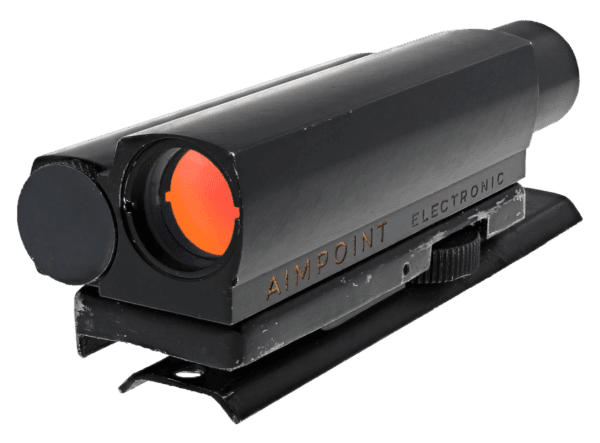
U.S.A. -(AmmoLand.com)- Red dot, reflex, and holographic gun optics have come a long way in the last 50 years, but the concept and development of this technology actually dates back to the early 1900s.
Electronic Origins
The Royal Dublin Society’s 1901 journal on scientific transactions talks about the creation of a “collimating-telescope gun-sight” designed by Sir Howard Grubb. As the term is a bit esoteric today, collimating sights allow the shooter to see an illuminated aiming point aligned with the gun it’s mounted on with little parallax.
The article waxes poetic on the history of telescopes and iron sights and how, at that time, it had never been easier to adapt and adopt some kind of telescopic sight, but also prattles on about construction, average shooters, and military constraints.
First Red Dot Sights
For all intents and purposes, the era of electronic optics started in 1974 with a little Swedish company known as Aimpoint. Named the Aimpoint Electronic, this new sight was the first electric red dot sighting system of its kind that utilized an LED to emit the red dot. It weighed about 12.5 ounces and was more than 6” in length – and these specs don’t include the added weight and bulk of the mount. By today’s standards, that’s massive, but it was cutting edge and totally reasonable since it was designed for use on a rifle.

In 1979, Laser Products Corporation introduced a pistol sight version when they brought the LPC Model 7 to market. The Model 7 came from their factory mated to a Colt Trooper MK III revolver. The massive helium-neon gas laser sight’s equally large battery was custom built into the gun’s extended Pachmayr grip, meaning that you couldn’t even use the sight with your own gun if you wanted to. It was this or nothing.
By the 1980s, it was becoming more common to use these sights in competition shooting, so they really began to take off and we saw more options coming onto the market. Still, they were heavy and burned through batteries like they were going out of style.
One of the popular early red dot sights was the Tasco ProPoint. In fact, it’s popular enough that even today, they still offer an improved version of the ProPoint.
Modern Electronic Optics
As we entered the new millennium, sights continued to improve. They got smaller, lighter, and conserved batteries.
Some of the models even led to the standardization of mounting options. C-More is used by the Vortex Razor and the Sig Sauer Romeo3. Docter/Noblex is used by the Burris FastFire and the Vortex Viper. Aimpoint Micro is used by Vortex Crossfire, Sig Sauer Romeo4 and Romeo5, and others.
Trijicon’s ACOG is, by far, the most notable advancement in electronic rifle scopes. With more than one million made, it has become a standard for the US military. In fact, retired General and former Secretary of Defense Jim “Mad Dog” Mattis called the ACOG the “biggest improvement in lethality for the Marine infantryman since the introduction of the M1 Garand in World War II.” High praise, for sure.

Today, electronic optics are more popular than ever. While there are still the expensive “name brand” options, there are plenty of others that have come into their own at lower price points and are trusted by just as many – if not more – shooters.

I’m not sure they can get much smaller, lighter, or longer-lasting, though. For example, the brand new HEX Wasp micro red dot sight from Springfield Armory is less than an inch high and wide, weighs 0.7 ounces, and boasts a battery life of more than 7 years on the lowest setting.
If you’re in the market for any kind of electronic optic, there’s never been a better time to buy. The market is bursting at the seams and prices keep coming down. Just be sure to do your homework first, though, because with so many options out there, it can get confusing and overwhelming if you don’t. No doubt you’ll find the perfect one for your purpose.
About Logan Metesh
Logan Metesh is a historian with a focus on firearms history and development. He runs High Caliber History LLC and has more than a decade of experience working for the Smithsonian Institution, the National Park Service, and the NRA Museums. His ability to present history and research in an engaging manner has made him a sought after consultant, writer, and museum professional. The ease with which he can recall obscure historical facts and figures makes him very good at Jeopardy!, but exceptionally bad at geometry.


Aimpoint was the first red dot with a battery but weaver had one I believe came out 1971 with no battery it used a light prism on the front of it the aimpoint was a lot smaller
Way back when the Aimpoint they send at the POW camp in N. Vietnam, didn’t use batteries. Had one. No, not there. Never used it on a pistol, bur on a close range rifle it worked well. Wish I still had it!
I’d like to read more about it.